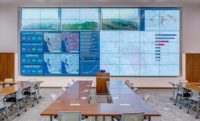In August of 2020, Telenet VoIP began a $600,000 integration project with the County of Los Angeles Department of Parks & Recreation. The department partnered with Telenet to install audio/visual, video surveillance, fire alarm, intrusion, paging address, sound enhancement, structured cabling, TV, data network equipment, phone and drowning analytics systems on site at the county’s Greater Whittier Regional Aquatic Center. The project — completed in July of 2022 — was put in place to protect swimmers and water polo players during meets.
According to Nick Payab, vice president, Telenet, the company’s mission is to “ensure that every Telenet VoIP customer believes that they are safe and secure and are able to achieve their own missions through the technologies and services we provide.”
Telenet operates primarily in Southern California, serving the K-12 market for all aspects of low voltage systems, engineering, design, installation, maintenance and support. For over 40 years, Telenet has demonstrated its ability to execute a wide range of technology projects: small, large, complicated, fast-track, multi-system and design-build. Payab says, “We are systems integrators at heart, and we bring that passion to work, every single day.
“Our primary market is K-12 sector,” Payab continues. “Our secondary market is municipalities.”
While Payab expressed that the Telenet team had experienced some delays during the Whitter project that negatively affected the deadline, the project was nevertheless completed. Payab also pointed to AngelEye’s drowning detection system as the most innovative solution deployed at the site. AngelEye utilizes a system of cameras, artificial intelligence-based algorithms and mobile notifications to monitor, detect and prevent drowning.
“This system is capable of saving lives, as it monitors and alerts of possible drowning,” Payab said. The “eye” in AngelEye is an optical sensor that combines LED lights capable of tracking the movements of swimmers in the pool. These cameras are durable and offer a high definition view of the bottom and edge of the pool — areas that are critical to the prevention of drowning. The underwater cameras monitor in conjunction with aerial cameras that identify whether swimmers are on the surface or underneath it. These cameras continually record which allows for the reconstruction of any dynamic of an event or incident.
AngleEye employs its LifeGuard software — the result of 15 years of development and testing on hundreds of different pools from around the world. The software consists of hundreds of algorithms combined with an innovative and specific artificial intelligence developed by AngelEye for drowning detection. The algorithms and artificial intelligence is then applied to the video, which recognizes and analyzes everyone in the pool and their movements.
The software scans and models in three dimensions allowing for the identification of the exact position of people in the water. Established in real time, AngelEye’s software can then set off alarms to alert life safety personnel.
AngelEye integrates a series of devices to notify any kind of danger to the safety personnel. These include smartwatches that can provide the lifeguards with an image and position of the danger in real time, as well as handhelds, screens, LED panels, sirens and light systems. — by Christopher Crumley, SDM Staff Editor









